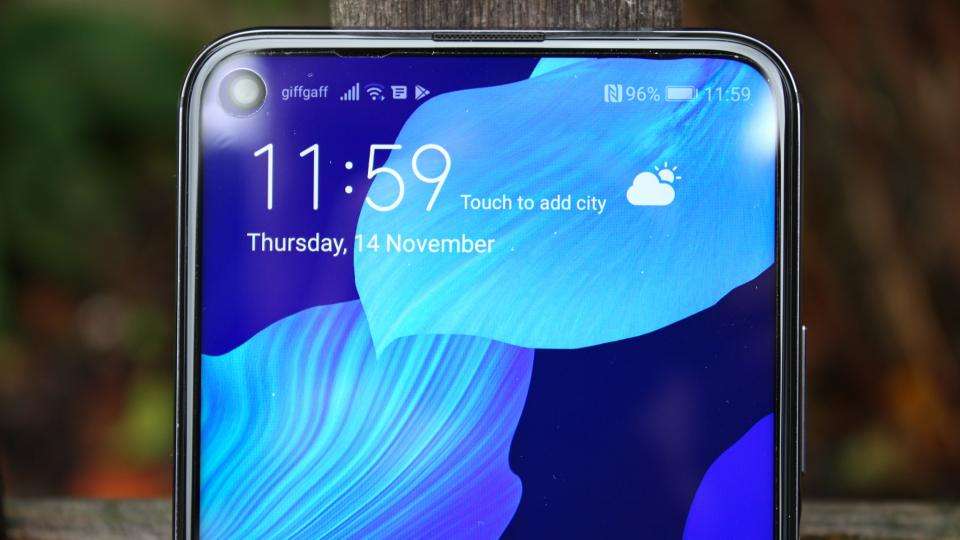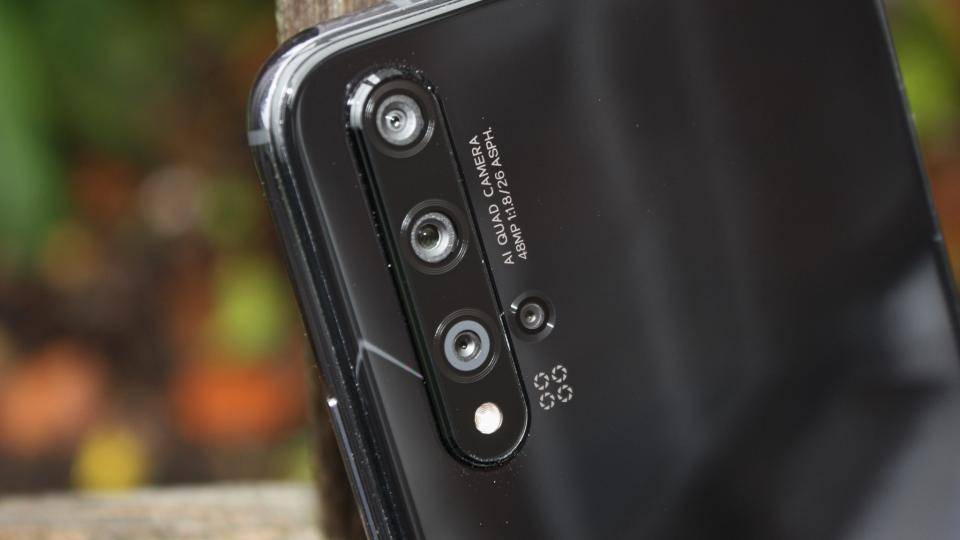At £399, Huawei has lined its Nova 5T up against our current favourite mid-range phone: the £399 Xiaomi Mi 9T Pro . With the same price and similar specifications, these two phones look almost perfectly matched on paper, but the burning question is whether Huawei has enough to knock the already established Xiaomi off its perch?
READ NEXT: The best mid-range smartphones
Huawei Nova 5T review: What you need to know
Start looking down the list of specifications and the phones appear superficially similar. The Huawei Nova 5T has a 6.26in screen that occupies most of the phone’s frontage. It uses the flagship Kirin 980 processor, which has already appeared in a smattering of Huawei and Honor phones, and is backed up with 6GB of RAM and 128GB of storage – although there’s no microSD slot.

There are five cameras dotted around the phone. On the rear, you'll find a standard 48MP sensor, a wide-angle camera and a depth-detecting camera for portrait effects, along with an extra macro lens for close-up photography. On the front, the selfie camera is located in the top left corner of the screen, which manages to dodge the notch problem by embedding the camera into the screen.
Huawei Nova 5T review: Price and competition
As I’ve already mentioned, with its £399 price tag, the obvious competitor to the Huawei Nova 5T is the Xiaomi Mi 9T Pro , which we reviewed in October and is currently our favourite phone in this mid-range price bracket. Although the processor is different, the supporting combo of 6GB of RAM and 128GB of storage are identical. Unfortunately, the Huawei’s IPS screen can’t rival the OLED effort of the Xiaomi, and its 3,750mAh capacity battery also falls short of the Mi 9T Pro’s 4,000mAh.

However, keep in mind that this is a very tough competitor and the Nova 5T is nipping at its heels. Although they’re a little cheaper, it’s also in the same ballpark as the larger-screened Samsung Galaxy A70 and the camera-focussed Vivo V17 Pro . Both have their own benefits but the Huawei Nova 5T is a comparative powerhouse when it comes to running Android and its apps.
Huawei Nova 5T review: Design and key features
Huawei has managed to minimise the bezel around the edge of the Nova 5T’s large 6.26in screen. The bezel at the bottom is the biggest, at 5mm thick, while the rest of the screen has a 3mm border. The display squeezes right into all four corners, following the curve of the chassis, which gives it a smooth, generous-feeling finish.
Unlike the Xiaomi and Vivo models, which use pop-up selfie cameras that are hidden within the phone when not in use, the Huawei Nova 5T’s front camera is embedded into the top left corner of the screen. This leaves a 4mm diameter black hole that’s a little intrusive, but marginally less so than a large notch. The hole doesn’t extend beyond the notification bar at the top but this doesn’t get away from the fact that it’s always visible in the corner if you’re watching a movie or playing a game.

On the back, there are four camera lenses, three of which are built into a raised, elongated lozenge alongside the camera flash, with the macro lens sitting to the side. This arrangement protrudes quite a bit, unbalancing the phone if it's resting on a table, giving it a bit of a wobble as you swipe and tap on a flat surface. On the bright side, it keeps the main body of the phone to a slim 7.87mm.
Unfortunately, there’s no way to expand the storage of the phone beyond its 128GB and there’s no 3.5mm headphone socket. The only port is a USB Type-C at the bottom, which is used to charge the phone.
Huawei Nova 5T review: Display
The Huawei Nova 5T’s IPS screen is excellent for what it is. Measuring 6.26in, it’s slightly smaller than the Xiaomi Mi 9T’s 6.39in AMOLED effort, though it has the same resolution of 2,340 x 1,080.
In the default ‘Vivid’ display mode, which is easily selectable from the settings menu, I found it was capable of displaying 98.4% of the sRGB colour gamut, which is only a whisker behind the Xiaomi. I also measured a maximum brightness of 422.9cd/m2, which is bright enough to see in sunny weather. Black and contrast levels are equally good, with an inky-looking black of 0.35cd/m2 and a good contrast of 1,215:1. However, as I mentioned previously, the Xiaomi Mi 9T Pro’s OLED screen looks much better.
Huawei Nova 5T review: Performance and battery life
Internally, the Huawei Nova 5T has power where it counts. Huawei’s homebrew octa-core Kirin 980 processor is backed-up by 6GB of RAM and 128GB of storage, which is a package that manages to hit a specification sweet-spot that matches its Xiaomi rival.
In our tests, the Kirin 980-powered phone rocketed through our Geekbench 4 benchmark, giving the Xiaomi’s Snapdragon processor a good run for its money. Its single-core result of 3,313 is streets ahead of the Samsung A70 and the Vivo V17 Pro, but it falls just behind the Snapdragon 855 of the Xiaomi. This is compounded in the multi-core tests, where the Nova 5T trounces its Samsung and Vivo rivals, but the Xiaomi sneaks further ahead yet again.
It’s a similar story in the GFXBench Manhattan tests, with the Huawei Nova 5T sprinting past both Samsung and Vivo phones but finding itself just behind the Mi 9T in the onscreen benchmark. As you can see from the graph below, the single frame per second isn’t going to make a great deal of difference in everyday gaming, but take away the screen from the results and you can see that the graphics hardware doesn’t perform as well as Xiaomi’s.
Huawei supplies a 3,750mAh battery in order to keep things ticking along. According to our usual battery life test – setting the screen to 170cd/m2 and looping a video until the battery dies – the Nova 5T lasted only 14hrs 36mins before needing to recharge. As you can see from our test results, this is actually the worst performing stamina of its peers.
You’d expect some drop in battery performance if you compare to the Samsung, Vivo and Xiaomi handsets, especially as they have bigger batteries, but this is far from ideal if you’re hoping to get through a day on a single charge – although you might just be able to make it to bedtime with moderate use.
Huawei Nova 5T review: Camera
On the rear of the phone, you’ll find four of the five cameras. The raised section incorporates the main 48-megapixel (f/1.8) sensor, along with the 16-megapixel (f/2.2) wide-angle camera and the 2-megapixel (f/2.4) depth assist camera. The fourth camera on the rear is offset from the others and is the 2-megapixel (f/2.4) macro sensor, which is configured to take close-up photos at a distance of 4cm.
In good light, the standard camera is decent for a mid-range phone, and the wide-angle option provides a bigger picture for when you need it. However, you could argue that a telephoto lens might have been more useful, since phone cameras are generally good at stitching together panoramas. In lower light the cameras work hard to produce serviceable shots, even getting surprisingly good images in very low light conditions.
On close inspection, however, there’s a lot of smoothing going on – which I suspect is due to rather heavy-handed image processing – so you don’t tend to capture a lot of details, but the photos are generally bright and clear. I was less convinced by the macro lens, but if you’re the type to take photos of small objects it might tip the scale in the opposite direction.
The selfie camera is a 32-megapixel (f2.0) sensor with a fixed focal length. You can add plenty of special effects to your Instagram vanity shots, and you can blur the background in a similar way to the depth sensor on the rear, though I found it wasn’t as good at detecting the edges of its subject, accidentally blurring out sticky-out hair around the edges, for example.
Video can be shot in 4K at 30fps or Full HD at either 60 or 30fps. I found the stabilisation worked well at all resolutions and frame rates, though it can appear to jump from one stabilised moment to the next if the camera is moving around too much
Huawei Nova 5T review: Verdict
If the Xiaomi Mi 9T Pro wasn’t on the scene, I’d be singing the praises of the Nova 5T from the rooftops. The difference between the two phones is subtle, but in our tests, the Huawei was always slightly behind in almost every area. The most significant shortfalls are that the screen is an IPS model instead of AMOLED, and while the Nova 5T’s display almost keeps up when it comes to both colour accuracy and brightness, it’s left in the shade when it comes to contrast.
The rest of the Nova 5T’s hardware provided an impressive set of statistics in our performance tests, but even here it can’t quite match the results of the Xiaomi. It’s much better than other similarly-priced phones, but it ultimately fails to topple our favourite.
